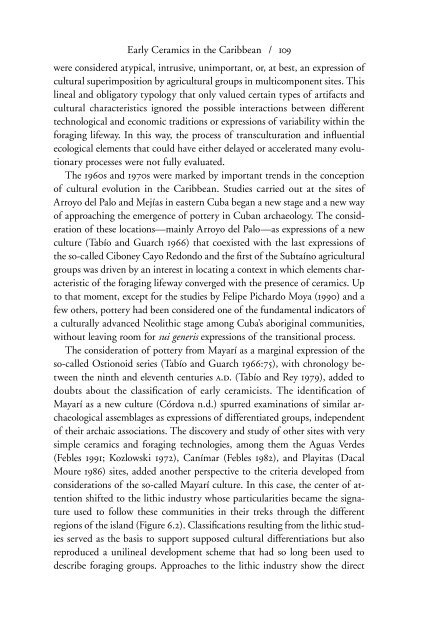Dialogues in Cuban Archaeology
by L. Antonio Curet, Shannon Lee Dawdy, and Gabino La Rosa Corzo
by L. Antonio Curet, Shannon Lee Dawdy, and Gabino La Rosa Corzo
You also want an ePaper? Increase the reach of your titles
YUMPU automatically turns print PDFs into web optimized ePapers that Google loves.
Early Ceramics <strong>in</strong> the Caribbean / 109<br />
were considered atypical, <strong>in</strong>trusive, unimportant, or, at best, an expression of<br />
cultural superimposition by agricultural groups <strong>in</strong> multicomponent sites. This<br />
l<strong>in</strong>eal and obligatory typology that only valued certa<strong>in</strong> types of artifacts and<br />
cultural characteristics ignored the possible <strong>in</strong>teractions between different<br />
technological and economic traditions or expressions of variability with<strong>in</strong> the<br />
forag<strong>in</strong>g lifeway. In this way, the process of transculturation and <strong>in</strong>®uential<br />
ecological elements that could have either delayed or accelerated many evolutionary<br />
processes were not fully evaluated.<br />
The 1960s and 1970s were marked by important trends <strong>in</strong> the conception<br />
of cultural evolution <strong>in</strong> the Caribbean. Studies carried out at the sites of<br />
Arroyo del Palo and Mejías <strong>in</strong> eastern Cuba began a new stage and a new way<br />
of approach<strong>in</strong>g the emergence of pottery <strong>in</strong> <strong>Cuban</strong> archaeology. The consideration<br />
of these locations—ma<strong>in</strong>ly Arroyo del Palo—as expressions of a new<br />
culture (Tabío and Guarch 1966) that coexisted with the last expressions of<br />
the so-called Ciboney Cayo Redondo and the ¤rst of the Subtaíno agricultural<br />
groups was driven by an <strong>in</strong>terest <strong>in</strong> locat<strong>in</strong>g a context <strong>in</strong> which elements characteristic<br />
of the forag<strong>in</strong>g lifeway converged with the presence of ceramics. Up<br />
to that moment, except for the studies by Felipe Pichardo Moya (1990) and a<br />
few others, pottery had been considered one of the fundamental <strong>in</strong>dicators of<br />
a culturally advanced Neolithic stage among Cuba’s aborig<strong>in</strong>al communities,<br />
without leav<strong>in</strong>g room for sui generis expressions of the transitional process.<br />
The consideration of pottery from Mayarí as a marg<strong>in</strong>al expression of the<br />
so-called Ostionoid series (Tabío and Guarch 1966:75), with chronology between<br />
the n<strong>in</strong>th and eleventh centuries a.d. (Tabío and Rey 1979), added to<br />
doubts about the classi¤cation of early ceramicists. The identi¤cation of<br />
Mayarí as a new culture (Córdova n.d.) spurred exam<strong>in</strong>ations of similar archaeological<br />
assemblages as expressions of differentiated groups, <strong>in</strong>dependent<br />
of their archaic associations. The discovery and study of other sites with very<br />
simple ceramics and forag<strong>in</strong>g technologies, among them the Aguas Verdes<br />
(Febles 1991; Kozlowski 1972), Canímar (Febles 1982), and Playitas (Dacal<br />
Moure 1986) sites, added another perspective to the criteria developed from<br />
considerations of the so-called Mayarí culture. In this case, the center of attention<br />
shifted to the lithic <strong>in</strong>dustry whose particularities became the signature<br />
used to follow these communities <strong>in</strong> their treks through the different<br />
regions of the island (Figure 6.2). Classi¤cations result<strong>in</strong>g from the lithic studies<br />
served as the basis to support supposed cultural differentiations but also<br />
reproduced a unil<strong>in</strong>eal development scheme that had so long been used to<br />
describe forag<strong>in</strong>g groups. Approaches to the lithic <strong>in</strong>dustry show the direct


















